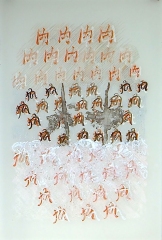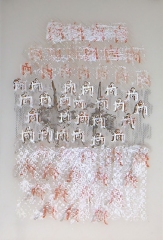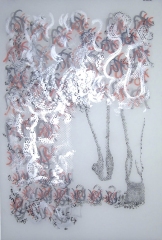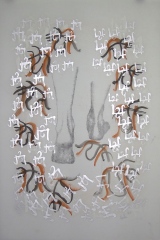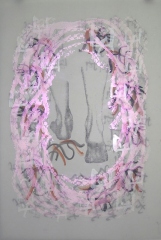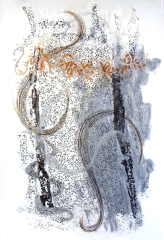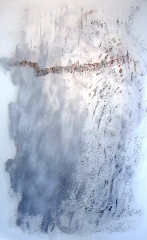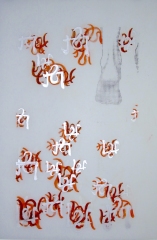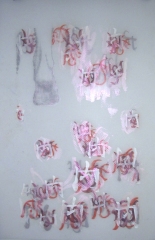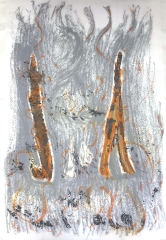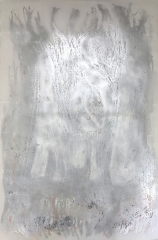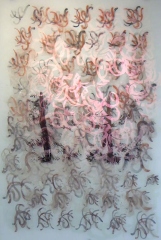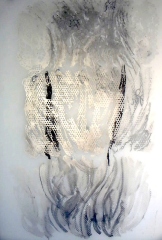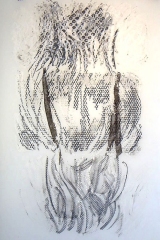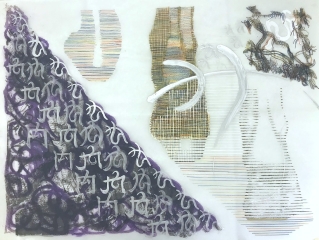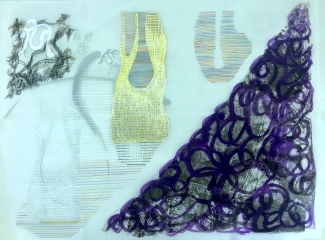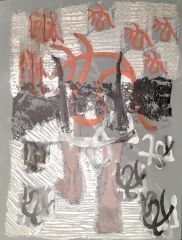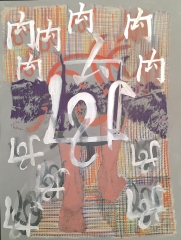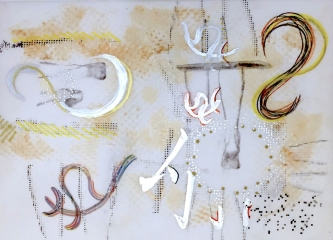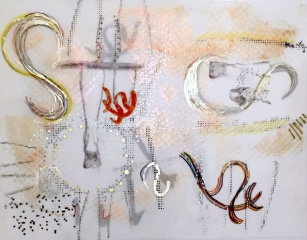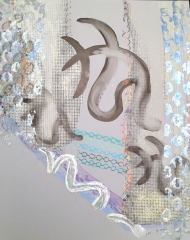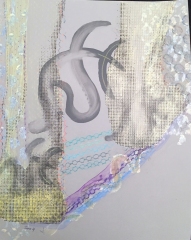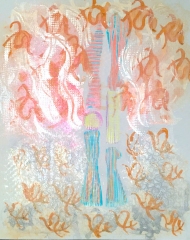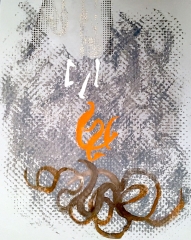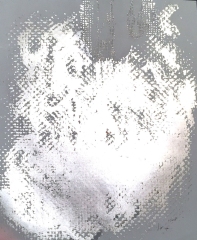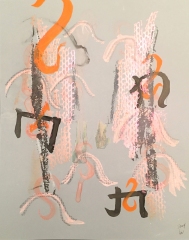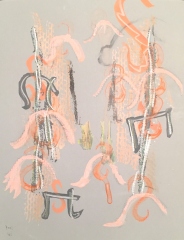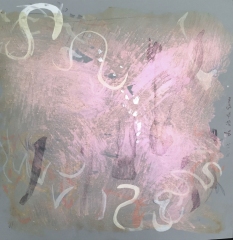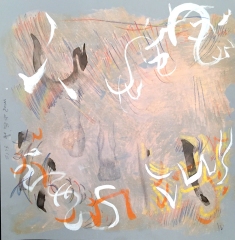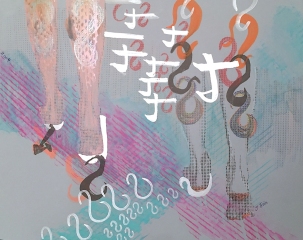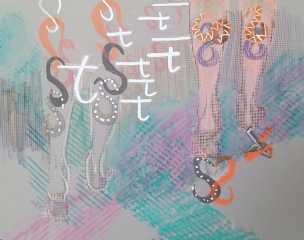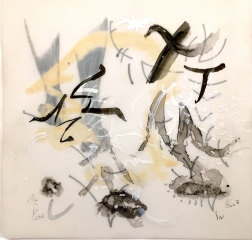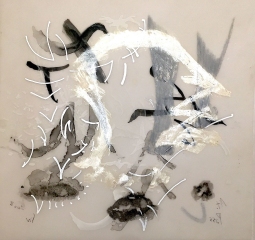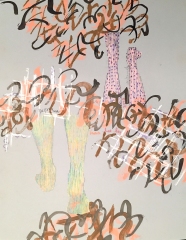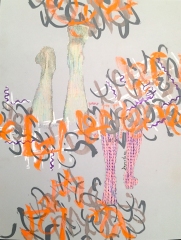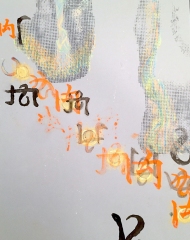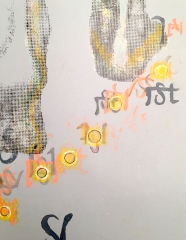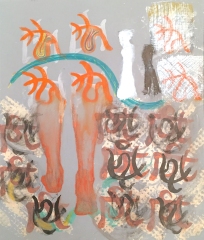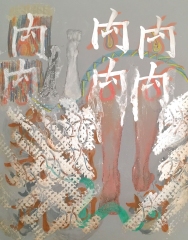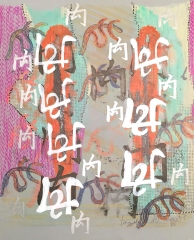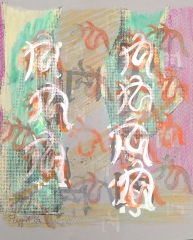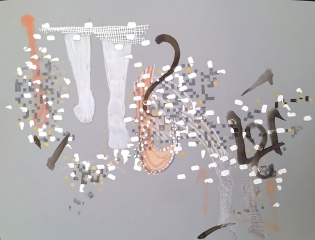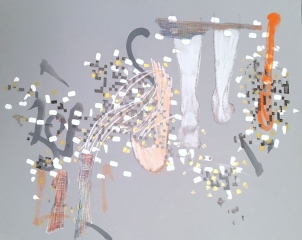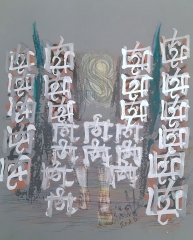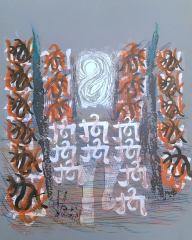Departure
Exhibited at Ch’i: An Art Space — Williamsburg, Brooklyn
December 19th 2003 — January 25th 2004
As we depart from the events of 9/11, many feel we are on a pinnacle of change.
The show explores intuitive musings regarding the meanings of “departure”, and the shapes of 4 Chinese ideograms for “to depart.”
Looking at the characters basic structure, I saw an image of a gate with a serpent passing through it.
“To pass through a gate” and “serpents” are symbols of change; and as such, correspond thematically to definitions of “departure.”
DEPARTURE (definition):
– a departing; going away; leaving
– a starting out, as on a trip or new course of action: as, political action is a new departure for labor.
– a deviation or turning aside (from something.)
– [archaic] death.
– in nautical usage: the distance of a ship due east or west from the meridian of its starting point (a ship’s position in latitude and longitude at the start of a voyage from which the dead reckoning is begun.)
_____________________________
2-sided REVERSIBLE PAINTINGS: xerox transfer, mica powder, Chinese ink, mixed media on brushed mylar
DEPARTURE’s REVERSIBLE PAINTINGS design relationships between a photographic element of human feet walking; and the Chinese ideograms for “to depart”. Over time, the Chinese character for “to depart” evolved into 4 changes, before becoming obsolete and removed from the dictionaries during the Cultural Revolution.
Traditional Chinese calligraphy has its own critical criteria concerning line and composition: foremost is the relationship between the horizontal and vertical strokes that make up the form of each character. To write beautiful calligraphy, one must arrive at a sense of balance and harmony before execution.
This balance as similar to the struggle Homo sapiens attempt to maintain as they walk upright. Their stance enables humans to depart from the realm of the strictly animal while ushering in consciousness. We engage in this constantly changing, precarious state of equilibrium, whilst heading toward our creations of civilization.
Each side of a piece displays variations: visual elements are partially obscured and change when the available light shifts.
This may suggest the turning of a page, a parallel universe, or a dream space, or a sensation of mindfullness regarding the body-mind connection; experienced while walking on the earth
_____________________________
DEPARTURE INSTALLATION: video, vintage steamer trunk, kimono, paper, mirror, boat ladder
Refers to a journey — perhaps of immigration to a new land and time. Video imagery housed inside a trunk, reflects into a mirror set on a boat ladder. In it a figure passes through several gates, and its soundscape passages are from all times and cultures.
In the film, 2 spaces are presented, one as a moving abstract of the protagonist’s interior world; and another that’s representational, where the protagonist’s movements (swimming in the sea, crawling, and walking) reference the meanings for “departure”.
DEPARTURE, TRT 10.00 minutes
Direction & Edit: Lili White;
Sound: Keith Strand & Lili White — Special Thanks to Momenta Art and The OutPost: CUTS & BURNS Residency; Williamsburg Brooklyn;
*********
Delibes — Lakme Air des bijoux: performed by Amelita Galli-Curci
Shinto Rice Cake Ceremony
Chopin — Piano sonata Nº 3 in B minor, Opus 58; performed by Nelson Goener
Unknown — As a beam o’er the face of the waters may glow; performed by Alma Gluck
As a beam o’er the face of the waters may glow
While the tide runs in darkness and coldness below,
So the cheek may be tinged with a warm sunny smile,
Though the cold heart to ruin runs darkly the while.
Haydn — chorus from Creation
Sid Hemphill — The Devil’s Dream; Afro-American Folk Music, Tate & Panola Counties, Mississippi; Library of Congress-Archive of Folk Culture
Ain’t Gonna Rain No More — sung by 8 unidentified girls; Deep River of Song, Alabama: from Lullabies to Blues; The Alan Lomax Collection
Ring, ring the big bell,
Ain’t gonna rain no more.
Fill me a pocket before I go,
It ain’t gonna rain no more
Chopin — Barcarolle Opus 50, performed by Nelson Goener
____________________
SHADOW BREATH BOXES: Clear glass lids etched with calligraphy forms cast their shadows onto the interior of the box.
